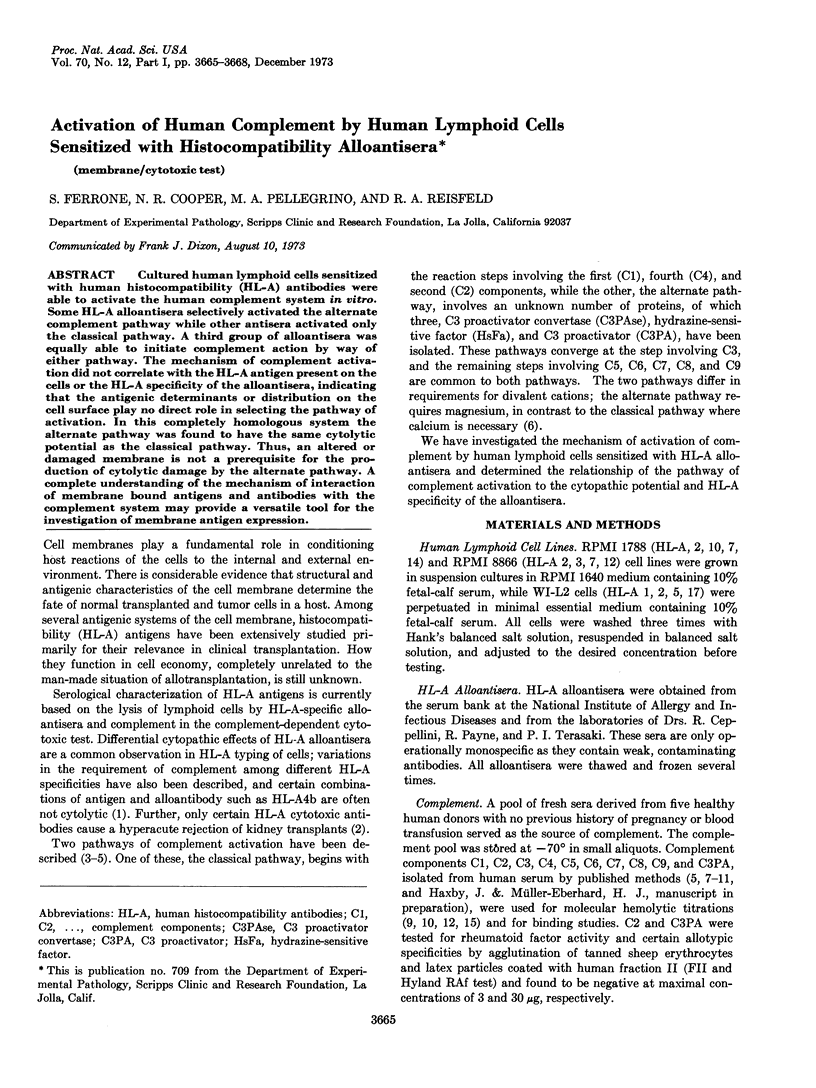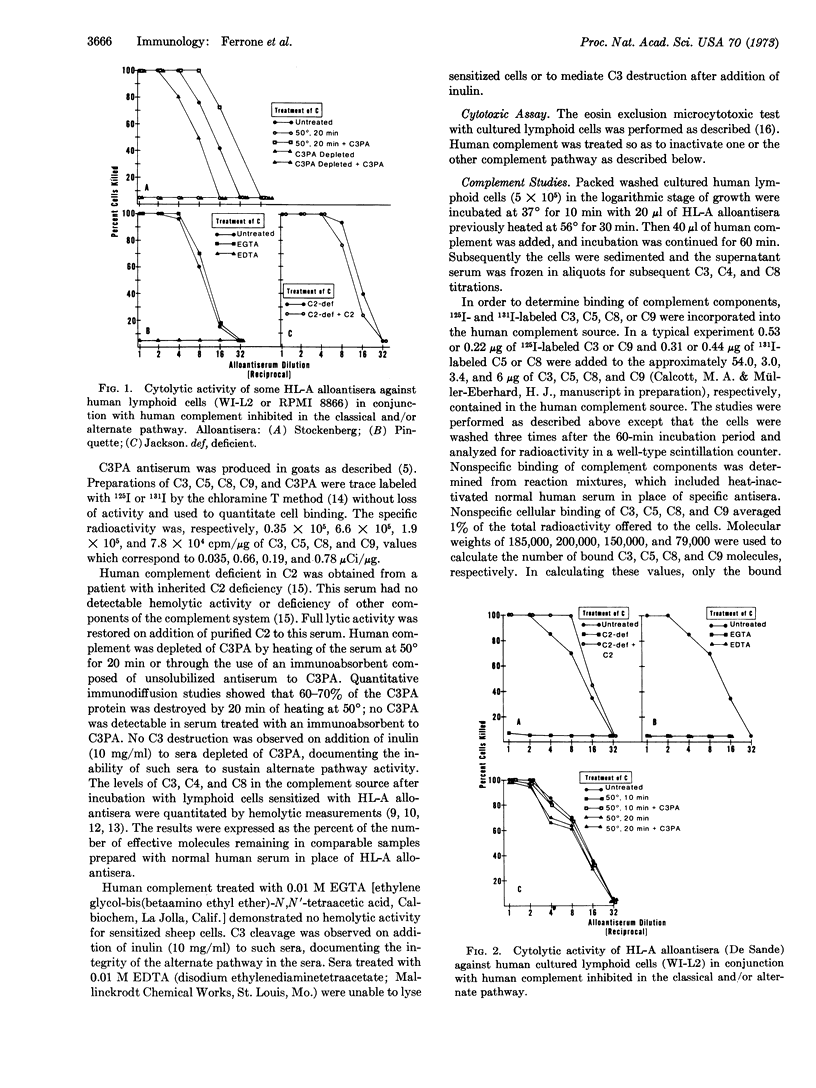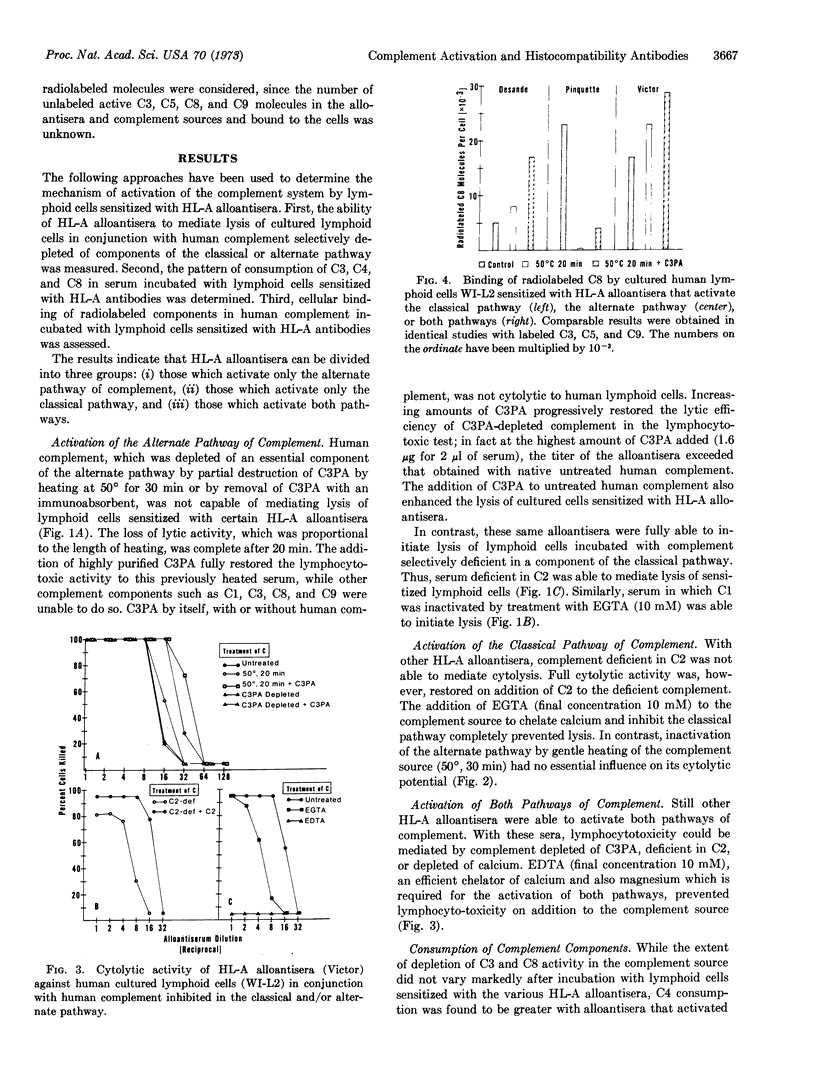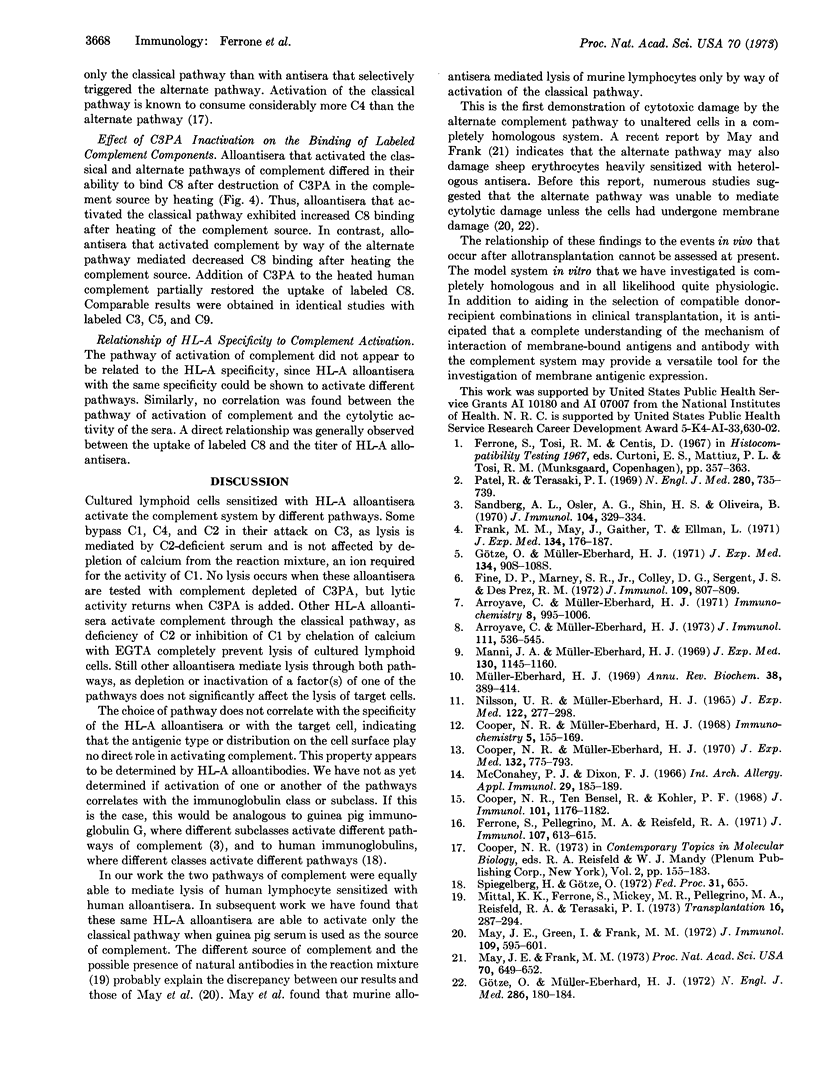Abstract
Cultured human lymphoid cells sensitized with human histocompatibility (HL-A) antibodies were able to activate the human complement system in vitro. Some HL-A alloantisera selectively activated the alternate complement pathway while other antisera activated only the classical pathway. A third group of alloantisera was equally able to initiate complement action by way of either pathway. The mechanism of complement activation did not correlate with the HL-A antigen present on the cells or the HL-A specificity of the alloantisera, indicating that the antigenic determinants or distribution on the cell surface play on direct role in selecting the pathway of activation. In this completely homologous system the alternate pathway was found to have the same cytolytic potential as the classical pathway. Thus, an altered or damaged membrane is not a prerequisite for the production of cytolytic damage by the alternate pathway. A complete understanding of the mechanism of interaction of membrane bound antigens and antibodies with the complement system may provide a versatile tool for the investigation of membrane antigen expression.
Keywords: membrane, cytotoxic test
Full text
PDF



Images in this article
Selected References
These references are in PubMed. This may not be the complete list of references from this article.
- Arroyave C. M., Müller-Eberhard H. J. Interactions between human C5, C6, and C7 and their functional significance in complement-dependent cytolysis. J Immunol. 1973 Aug;111(2):536–545. [PubMed] [Google Scholar]
- Arroyave C. M., Müller-Eberhard H. J. Isolation of the sixth component of complement from human serum. Immunochemistry. 1971 Nov;8(11):995–1006. doi: 10.1016/0019-2791(71)90487-3. [DOI] [PubMed] [Google Scholar]
- Cooper N. R., Müller-Eberhard H. J. A comparison of methods for the molecular quantitation of the fourth component of human complement. Immunochemistry. 1968 Mar;5(2):155–169. doi: 10.1016/0019-2791(68)90100-6. [DOI] [PubMed] [Google Scholar]
- Cooper N. R., Müller-Eberhard H. J. The reaction mechanism of human C5 in immune hemolysis. J Exp Med. 1970 Oct 1;132(4):775–793. doi: 10.1084/jem.132.4.775. [DOI] [PMC free article] [PubMed] [Google Scholar]
- Cooper N. R., ten Bensel R., Kohler P. F. Studies of an additional kindred with hereditary deficiency of the second component of human complement (C2) and description of a new method for the quantitation of C2. J Immunol. 1968 Dec;101(6):1176–1182. [PubMed] [Google Scholar]
- Ferrone S., Pellegrino M. A., Reisfeld R. A. A rapid method for direct HL-A typing of cultured lymphoid cells. J Immunol. 1971 Aug;107(2):613–615. [PubMed] [Google Scholar]
- Fine D. P., Marney S. R., Jr, Colley D. G., Sergent J. S., Des Prez R. M. C3 shunt activation in human serum chelated with EGTA. J Immunol. 1972 Oct;109(4):807–809. [PubMed] [Google Scholar]
- Frank M. M., May J., Gaither T., Ellman L. In vitro studies of complement function in sera of C4-deficient guinea pigs. J Exp Med. 1971 Jul 1;134(1):176–187. doi: 10.1084/jem.134.1.176. [DOI] [PMC free article] [PubMed] [Google Scholar]
- Götze O., Müller-Eberhard H. J. The C3-activator system: an alternate pathway of complement activation. J Exp Med. 1971 Sep 1;134(3 Pt 2):90s–108s. [PubMed] [Google Scholar]
- Manni J. A., Müller-Eberhard H. J. The eighth component of human complement (C8): isolation, characterization, and hemolytic efficiency. J Exp Med. 1969 Nov 1;130(5):1145–1160. doi: 10.1084/jem.130.5.1145. [DOI] [PMC free article] [PubMed] [Google Scholar]
- May J. E., Frank M. M. A new complement-mediated cytolytic mechanism--the C1-bypass activation pathway. Proc Natl Acad Sci U S A. 1973 Mar;70(3):649–652. doi: 10.1073/pnas.70.3.649. [DOI] [PMC free article] [PubMed] [Google Scholar]
- May J. E., Green I., Frank M. M. The alternate complement pathway in cell damage: antibody-mediated cytolysis of erythrocytes and nucleated cells. J Immunol. 1972 Sep;109(3):595–601. [PubMed] [Google Scholar]
- McConahey P. J., Dixon F. J. A method of trace iodination of proteins for immunologic studies. Int Arch Allergy Appl Immunol. 1966;29(2):185–189. doi: 10.1159/000229699. [DOI] [PubMed] [Google Scholar]
- Mittal K. K., Ferrone S., Mickey M. R., Pellegrino M. A., Reisfeld R. A., Terasaki P. I. Serological characterization of natural antihuman lymphocytotoxic antibodies in mammalian sera. Transplantation. 1973 Oct;16(4):287–294. doi: 10.1097/00007890-197310000-00003. [DOI] [PubMed] [Google Scholar]
- Müller-Eberhard H. J. Complement. Annu Rev Biochem. 1969;38:389–414. doi: 10.1146/annurev.bi.38.070169.002133. [DOI] [PubMed] [Google Scholar]
- NILSSON U. R., MUELLER-EBERHARD H. J. ISOLATION OF BETA IF-GLOBULIN FROM HUMAN SERUM AND ITS CHARACTERIZATION AS THE FIFTH COMPONENT OF COMPLEMENT. J Exp Med. 1965 Aug 1;122:277–298. doi: 10.1084/jem.122.2.277. [DOI] [PMC free article] [PubMed] [Google Scholar]
- Patel R., Terasaki P. I. Significance of the positive crossmatch test in kidney transplantation. N Engl J Med. 1969 Apr 3;280(14):735–739. doi: 10.1056/NEJM196904032801401. [DOI] [PubMed] [Google Scholar]
- Sandberg A. L., Osler A. G., Shin H. S., Oliveira B. The biologic activities of guinea pig antibodies. II. Modes of complement interaction with gamma 1 and gamma 2-immunoglobulins. J Immunol. 1970 Feb;104(2):329–334. [PubMed] [Google Scholar]



